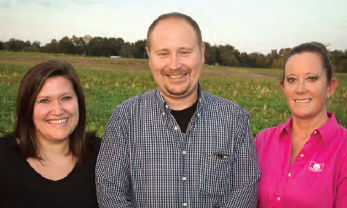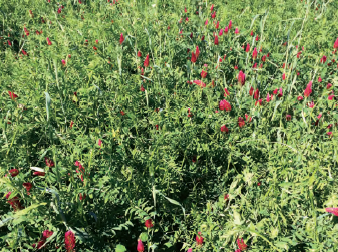February 28, 2017
The American Soybean Association (ASA) congratulates the regional winners of the 2016 Conservation Legacy Awards.
Matt Griggs, Humboldt, Tenn. (South Region)
Each winner will be recognized at the ASA Awards Banquet on March 3, 2017, at Commodity Classic in San Antonio, Texas. During the banquet, one of the farmers will be chosen as the national winner.
Check out the story of Matt Griggs.
When Matt Griggs was first introduced to conservation-minded farming, it nearly broke his heart. In the mid-1990s, his father, Bobby, broke the news that the farm was transitioning from full conventional tillage to no-till methods. “I was a teenager, and loved driving tractors,” Matt says. “I literally cried. I asked Dad, ‘What are we going to do all summer long?’” 
Those tears have long since dried.
The Griggs family farm in west Tennessee now pushes the boundaries of sustainable agriculture by exploring new ways to not only protect, but restore the farm’s most important natural resource, its soil.
“Historically, this area has been primarily devoted to cotton,” Matt says. “Until the end of the 20th century, it was primarily farmed by conventional tillage on soil types that are highly erodible. I have seen on my farm the destruction that 100 years of cotton mono-cropping and intensive tillage can do. My topsoil, in some places, has been reduced to only 2 to 3 inches deep.”
Family effort
That’s why the Griggs family has turned its attention to improving the soil and helping it regain its productivity. And it’s truly a family effort.
Matt Griggs’ great-great-grandfather started the farming operation and a cotton gin in 1882 at its current location.
Every generation of the Griggs family that has come along since then has contributed to this Tennessee Century Farm in some way. Matt came back to the farm after graduation from college in 2002 to farm with his father; when Bobby passed away in 2005, Matt took over operations with the help of his sister, Jocelyn Griggs Bundy, who keeps the farm’s financial records, and assistance from her husband, Eric Bundy, who serves as a “technical guru” on computer and digital issues.

Matt got married in 2005, and beginning in 2008, his wife, Kelly, devoted herself to full-time farm work, learning to operate all the heavy equipment and hauling grain in semi rigs. Many cousins and other relatives also pitch in as needed.
Matt credits a soil science professor, Dr. Bob Duck, with sparking the turnaround in his thinking about conserving the soil. “During my junior and senior years at the University of Tennessee-Martin, Dr. Duck convinced me to see that soil is more than just dirt.
He got me interested in it, and got me to questioning how we could do things that benefit the soil.”
Matt started incorporating other crops, specifically winter wheat, into the farm’s rotation, and almost immediately saw improvements in the soil. “It happened quickly,” he recalls. “We started to see increased organic matter, and yields started to improve. Our crops seemed to show a little less summer stress. That really encouraged me to start picking up more of these practices.”
Dealing with summer stress is one of the driving factors behind the Griggs family’s efforts to boost soil health.
“Here in Tennessee, we are subject to all kinds of weather extremes,” Matt points out. “Dry weather and high summer temperatures really put a stress on the crop.”
Water is usually the biggest limiting factor on crop production in west Tennessee. Ironically, the area receives about 52 inches of precipitation a year.
“We get plenty of moisture, we just don’t always get it at the right time,” he points out. “For each 1% of organic matter increase in the soil, we get anywhere from a half inch to an inch more water storage. In late July and August, that can make a huge difference — the difference between a breakeven crop or a profitable crop.”
His goal is to keep the water on the farm as long as possible. “The experts tell me that we don’t have a runoff problem here in west Tennessee, we have an infiltration problem,” Matt says.
“If rainfall is going into the ground, it is not going across the ground, removing nutrients, topsoil, and residue. So my biggest goal is to get as much water as I can into the ground.”
In order to do that, he follows a number of conservation techniques such as terracing, contour farming, and water retention basins, but the real improvement has come by a commitment to cover crops. Matt started to experiment with radishes as a cover crop in 2011, then began to add other species such as cereal rye, vetch, winter peas, and crimson clover. He’s now using a cover-crop cocktail, typically a mix of five to seven different species, on 100% of the farm’s fields that are not planted to winter wheat.
“With cover crops, I am really starting to see improvements in my infiltration,” he says. “I have documented a 600% improvement in infiltration rates behind cover crops; an infiltration rate of 62 inches per hour for the first inch, and 12 inches per hour for the second inch. That compares to 2 inches per hour for straight no-till.”
When a summer thunderstorm drops an inch or two of rainfall in 30 minutes, “I know that I can capture all of it and store it,” Matt adds. “It can be used by the crop instead of capturing just a couple of tenths of an inch, with the rest running off into the creek.”
More productive
Boosting the soil works hand-in-hand with the Griggs family’s efforts to squeeze the most productivity out of the land with the fewest inputs.
Chicken litter applied over the top of cover crops in winter months helps build soils, while lime, phosphorus, and potash are variable-rate applied based on crop removal or soil test results — based on 2.5-acre grids. Both practices help protect the environment by applying only the right amount of nutrients where they are needed. All nitrogen needs for corn are variable-rate applied based on plant population.
Yields have responded to this change in approach; Matt documents a 100% increase in soybean yields compared to the farm’s baseline from 15 years ago; corn yields are up 50%, cotton yields are up 30%, and wheat yields have been boosted 35%.
Still, Matt sees the farm in the early stages of its journey. “I am at a good starting point on improving soil health,” he says. “But I want to go so much further. I really don’t know what the limit is on how much I can improve, but I want to see steady, measurable improvements each year, whether that is infiltration rates, organic matter increases, or fertility increasing. I will never get to the point that I think I have arrived.”
He thinks recent changes in how the farm terminates cover crops may open the door to more rapid improvement in soil quality. “In my opinion, to get the full benefit out of cover crops, they need to be terminated close to maturity,” he says. “High biomass is the quickest way to improve the soils and experience the immediate benefit from cover crops, which is weed control.”

Matt originally thought cover crops should be terminated early. “I have gotten away from early termination to ‘planting green,’’’ he says. “We now use a roller-crimper to terminate the crop, along with some herbicide to terminate a few of the species. Typically, the last couple of weeks that cover crops are growing is where you are going to get your biomass, and biomass is where you get an organic matter increase, and better control of weeds.” Custom made row cleaners that Matt designed have helped him handle this high residue mat, improving stands particularly for shallow-seeded cotton.
The Griggs family commitment to conservation is unwavering. “The Good Lord has given us the perfect system,” Matt says. “We just need to follow His design to help feed the world.”
You May Also Like




